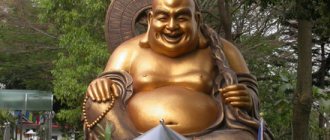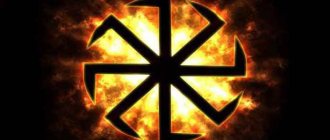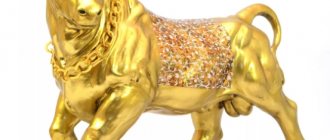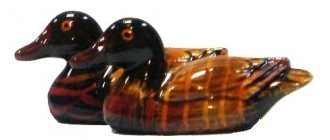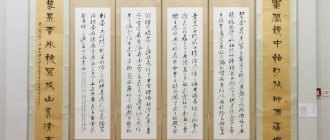From this article you will learn:
- What symbols represent Buddha in Buddhism?
- What are the 8 good symbols in Buddhism and what do they mean?
- What 8 Precious Objects did Buddha Receive?
- What symbolic objects are used to offer to Buddha?
Buddhism has its roots in the 4th–6th centuries. BC e. - the period when Siddhartha Gautama began to popularize his own religion in India about trials, the achievement of Nirvana and spiritual rebirth. Siddhartha did not welcome the use of his image, and in order to illustrate his teachings, he used various signs. There are special symbols of this religion that Buddha received as a gift from God after his enlightenment. We will tell you what each important symbol of Buddhism means in this article.
The history of the appearance of Buddhist symbols
There is a beautiful legend about how eight auspicious symbols appeared in our world.
According to this legend, on the day Buddha attained enlightenment and higher wisdom under the sacred tree, many gods came to pay their respects and presented him with gifts - eight auspicious symbols.
Brahma presented the deity to the Enlightened One with the Dharmachakra (Wheel of Learning). The heavenly god Sakra gave the White Shell to spread the wisdom of the Buddha to each end of the Universe. The earthly god Stavara handed the Buddha a Precious Vessel full of the drink of eternal life. The remaining gods presented Buddha with a pair of Golden Carps, a Lotus, a Victory Banner and a Good Umbrella.
All these symbols in Buddhism became sacred, demonstrating the close connection of the divine with the human world.
We have selected interesting articles for you:
The most powerful runes to attract unconditional love
20.03.2019
The meaning of the Valkyrie amulet - an ancient symbol of warriors
20.03.2019
Symbolism of Buddhism and images of Buddha
Siddhartha Gautama opposed his followers and admirers to worship him. Therefore, both his own images and the images of his teachings do not belong to the period of his life. However, Gautama expressed his thoughts metaphorically in his sermons and used certain images, for example, when he talked with his students on the topic of turning the wheel of Dharma.
The main symbols of Buddhism and their meaning became known after the death of Gautama. For the most part, these were images reflecting his philosophy of life. The earliest sacred signs of Buddhism are the stupa and the wheel of Dharma.
As the religion spread and divided into different teachings, the symbols of Buddhism became more and more numerous. This religion gradually borrowed elements from the cultures with which it came into contact.
To depict the Enlightened One in different periods, the following symbols of Buddhism were mostly used:
- Wheel with 8 spokes, or Dharmachakra. Symbolizes the turning of the Enlightened Wheel of Truth and the change of fate.
- Bodhi. This tree is a symbol of Buddhism. It is believed that Gautama became Enlightened while sitting under him.
- Buddha's footprints. According to legend, he left footprints on the stone to remind his descendants of his presence in their material world.
- Empty Throne. Reminiscent of Gautama's royal origins and carries the idea of spiritual dominion.
- Begging bowl. A sign of Buddha's renunciation of all material goods. The bowl also symbolizes the lifestyle of a monk.
- A lion. One of the strongest symbols. According to tradition, the lion represents the rights of the ruler, strength and power.
Much later, the “Eyes of Buddha” symbol appeared, which can now often be found in Nepal. The Enlightened One looks in all four directions, which means his all-seeing mind.
Endless knot
Some Buddhist symbols have multiple interpretations. And the endless knot falls into this category. For some it is the endless cycle of existence, for others it is a symbol of eternity, for others it is a sign of the inexhaustible knowledge of the Buddha. It is also a sign of the interdependence of all events in the Universe and the complex relationship between compassion and wisdom in the process of achieving Enlightenment. And to achieve it, you need to overcome the endlessly long path of the Mahayana. The path of the Bodhisattva is quite long and includes many kalpas.
There is also a hypothesis that the endless knot reflects another symbol, consisting of 2 intertwined snakes. The snake is one of the most ancient signs of kundalini, which came to India from Ancient Egypt. Most likely, the endless knot has a connection with the chandali. This is supported by the theory that the intertwining serpents are very similar to the movement of kundalini through the left and right channels of the etheric body.
Good symbols: precious vase and lotus flower
A precious vase is a symbol of realization, good intentions, and fulfillment of desires. She represents prosperity and longevity. That is why it is also called the vase of abundance. A precious vase has an amazing property: no matter how much jewelry you take from it, it will still remain full. Commonly used in Buddhist rituals.
The vase of abundance looks like a vessel richly decorated with gold, precious stones and a pattern of lotus petals that wrap around the entire surface of the vase. The top edge of the precious vessel is inlaid with either a single jewel, which fulfills any desire, or a group, which consists of 3 jewels, which symbolize the Buddha, Dharma and Sangha.
The neck of the vase is tied with a silk scarf that belongs to the world of the gods, and the opening of the neck is sealed with a tree that fulfills any desire. According to legend, the roots of the wishing tree are the source of water for longevity and all types of wealth. In addition to abundance, a precious vase also symbolizes peace, which is why it is often buried in the ground on the territory of Buddhist monasteries and temples.
Lotus flower
The lotus flower can be considered the most widespread and famous of all the auspicious symbols of Buddhism, which is known even to people far from this movement.
The lotus flower grew in a swamp, but was pure and unsullied. Therefore, it is primarily a symbol of purity. It also means independence from Samsara, although it remains in a cycle, like all living beings.
The lotus symbolizes the teachings of the Buddha: if you diligently practice it, then a person will eventually get rid of any kind of obscurations and attachments and become pure.
The lotus is a symbol of perfection, sacred origin, purity of body, spirit, mind and speech. He personifies innate perfection and the manifestation of the noblest qualities.
Thus, adherents of Buddhism are often depicted standing or sitting on a lotus flower, thereby depicting their involvement in sacred origin and independence from all the imperfections of the circle of Samsara. Lotus comes in different colors: white, yellow, red, pink, blue, black, gold.
Victory Banner
This symbol of Buddhism signifies the triumph of Dharma over ignorance, as well as the passage of the obstacles of Mara. This banner is located on the top of a mountain called Sumeru. As long as the Universe exists (the Heaven of Brahma and the World of Passion), this mountain of Perfection will be indestructible. Consequently, it is simply impossible to destroy the teachings of the Savior.
Sink
Like other symbols of Buddhism, it has its own meaning. A white shell with a spiral twisting to the right is considered a sign of the Savior’s enlightenment, as well as good news to all beings about the opportunity to achieve his nature. In ancient times, the conch shell was a musical instrument (wind instrument). It is therefore not surprising that it symbolized sound that spread in all directions. Likewise, the teachings of the Buddha are transmitted everywhere, calling on all beings to awaken from the sleep of ignorance.
Most often in nature there are shells in which the spiral twists to the left. Shells with a right-handed spiral are very rare. It was they who were associated in the minds of people with special characteristics and were considered sacred. The direction of their spirals was associated with the movement of celestial bodies: stars, planets, including the Moon and the Sun.
Offerings
Making offerings is a common practice in the East. In Tibet they are symbolized by small bowls filled with water, flowers, incense, candles, incense and food. This is due to the ancient tradition of receiving dear guests. The gifts are as follows:
- Water to cleanse your mouth or face. This means all favorable causes and conditions that bring positive effects.
- Water for washing feet. It is mixed with incense or sandalwood oil. The symbolic meaning is purification, getting rid of negative karma and obscurity.
- Flowers. The personification of generosity and an open heart.
- Incense symbolizes discipline and focus. They are an intermediary in communication between a person and the Buddha. Also means perseverance or joyful effort. Thanks to this quality, a person approaches enlightenment.
- Light is a symbol of stability and clarity, beauty that dispels ignorance.
- Food that has many different tastes means samadhi, nectar or ambrosia, which will “feed” the mind.
- Musical instruments. Their nature is wisdom, beneficial to the ears of Buddhas, Bodhisattvas and all enlightened beings. All phenomena have a nature of interdependence, causes and conditions, but sound is especially easy to understand.
Eight Auspicious Signs
Many of us may not know how important the eight auspicious signs are and the impact they have on our lives. They can be used externally to promote our success, and they can contribute to success in benefiting others and in working to spread the Buddha's teachings. Placing these eight auspicious signs everywhere, outside and indoors, makes things very auspicious. There is no need to place all eight auspicious signs together, and there is no need to place them in the same place. They can be placed separately in different places, but you should have them all.
The eight auspicious signs are the umbrella, the yellow fish, the vase, the lotus, the white shell, the delightful pyo or “endless knot,” the banner [of victory over the senses], and the dharmachakra (wheel of dharma). Below are the meanings of the eight auspicious signs as explained by His Holiness Trijang Dorje Chang.
1. Precious umbrella - (Tib. dug) a symbol of royal greatness and protection, wealth, power and social status. The coolness provided by the precious umbrella protects from the scorching rays of suffering, irresistible unfulfilled desires, neuroses and harmful forces.
The precious umbrella saves us from all the obstacles of this life, such as diseases, infectious diseases, spirit possession, interference and the like, as well as from the obstacles of the next life - the suffering of the three lower worlds, the world of gods, the world of people, etc. He completely saves us from the burning heat of both temporary and long-term suffering. By virtue of dependent generation, the umbrella gives us the endless joy of the cool shade of peace and happiness.
2. A pair of goldfish (Tib. sernya). Fish swim as they please in the ocean without fear. So, goldfish are an interdependent creation for themselves and for others, to live and rejoice freely, without resistance, from happiness to happiness, without the fear of drowning in the ocean of suffering.
3. Vase (tib.bumpa) - a symbol of a secret treasure, a repository of nectar of prosperity, health and long life. Jewels pour out of it in an inexhaustible stream, giving those who develop on the spiritual path protection from poverty and untimely death.
The great treasure vase is a dependent generation, endlessly brings all the desired things, good fortune of a glorious life, pleasures, etc. in the three spheres of existence (the world of desires, the world of forms and the world without forms) and peace (liberation from samsara).
4. Lotus (Tib.; pema) indicates Awakening - the full blossoming potential of the Buddha. Just as a lotus flower grows from mud and mud and opens, preserving its beauty unsullied on the surface of a swamp, so too are beings breaking through the defilements and obscurations of samsara, carrying through life the shining qualities of the absolute - “mind”, such as intuitive wisdom, joy , fearlessness, active compassion and love.
The lotus, the interdependent generation, frees us from all traces of errors - non-virtues of body, speech and mind. The abundant flowering of hundreds of petals of white virtue brings an abundance of precious nectar - lasting happiness and undoubted goodness (liberation and the state of omniscience).
5. The white conch (Tib. dungkar) [the spiral of which] twists clockwise is an interdependent generation that proclaims the wonderful melody of the deep and vast Dharma, which corresponds to all the elements, levels of consciousness and desires of all living beings that are objects of pacification. She awakens living beings from the ignorant sleep of ignorance and persuades them to act for the benefit and sake of their own happiness and the happiness of [other living beings].
6. Delightful pyo, or endless knot (Sanskrit shrivatsa, Tib. dpal be'u, Tib. palbeu) - a symbol of the infinity of intellectual knowledge and the non-conceptual depth of the Teachings of the Buddha (Dharma). Demonstrates the interdependence of all conditioned things and phenomena manifesting in the world, as well as the unity, non-duality of manifestations and emptiness.
It is the interdependent generation of Dharma and the desire to use and support each other in one continuous connection. When Buddhahood is achieved, omniscience and compassion are united.
7. Victorious Banner (Tib. Gyaltsen) - a sign of military superiority. It means victory over suffering, death and ignorance. It is a symbol of victory over all internal and external limitations, overcoming all obstacles - mainly these are two veils: the five interfering feelings (and their combinations) and rigid ideas.
The banner is the interdependent generation of the activity of our three gates and the gates of others, so that they are not hindered by obstacles and unfavorable conditions in order to gain victory over [the gates]; so that the precious teachings of the Buddha will be victorious in the war against the dark side, maras of all types.
8. Wheel of Dharma (Sansk. Dharmachakra; Tib.; chekkyi khorlo) - a symbol of the granting of liberating Teachings by the Buddha. Buddhas spin the golden wheel of Dharma in all worlds to help beings get rid of ignorance, the source of all suffering.
The Golden Dharmachakra is the interdependent generation of the precious wheel of the holy Dharma, the scriptures and the realizations of the Victorious One, so that it rotates ceaselessly throughout the entire universe. As a result, all reborn and degraded beings (samsaric beings who are reborn and die again and again under the control of karma and obscurations) can lead themselves to the best virtue, complete liberation.
Wherever these eight auspicious signs are present, there will be an interdependent generation of an increase in the virtue of auspiciousness.
They can also appear as independent symbols.
A frequent motif for jewelry and ornaments. Eight good symbols of the Dharma adorn ritual scarves-offerings hadakas, cymbals, and are found in national household items, clothing, and in the symbolism on banknotes and coins of Buddhist countries. For example, the conch shell is a symbol that appears on the coins of Bhutan. Eight Dharma symbols surround the Buddha Vairocana in his mandala. ________________________________
Here is Tashi Gyepa (Favourable Prayer) - it is recommended to perform it before starting any good deed
༄༅། ཞུགས་སོ། །
ཨོཾ། ། OM | NANGSI NAMDAG RANGSCHIN LHUNDRUP PAY OM. Where all phenomena are completely pure and spontaneous,
། DRAG CHOGCHUY SHINGNA SHUGPA YI In the auspicious kingdoms of the ten directions
། SANGYE CHE DANG GENDYUN PHAGPEY TSOG Buddha, Dharma and Noble Sangha abide;
KYUNLA CAGTSEL DAGCHAG TASHI SHOG Thanks to the expression of respect to them, may everything be favorable for us!
ས། ། DRONMEY GYELPO TSELTEN DONDRUB GONG Dipankara, Sthira Kaushala Madhashaya,
། JAMPEI GYENPEL GEDRAG PELDAM PA Sri Maitreya Lankara, Sri Varashu Bhakirti,
། KYUNLA GONGPA GYACHER DRAGPA CHEN Sarva Shayodara Kirtiman,
LHUNPO TARPHAG TSELDRAG PELDANG NI Sri Sumeru Vadaya Kaushalakirti,
། SEMCHEN TAMCHE LAGONG DRAPEY SING Sri Arvasattva Shayakirti,
། YITSIM DZEPA TSELDRAB DRAGPEL TE Sri Mantu Shakara Kaushalasukirti,
། TENTS TOPEY TASHI PELPHEL VA Hearing their names increases auspiciousness and success.
། DE VAR SCHEGPA GYELA CAGTSEL LO Respect to the eight Sugatas!
། JAMPEL SHONNU PELDEN DORJE JIN Young Manjushri, illustrious Vajrapani,
། CHENREZIG WANG GONPO JAMPEI PEL Avalokiteshvara, protector of Maitreya,
ས་ྒྲིབ་པ་རྣམ་པར་སེལ། ། SAI NYINGPO DRIBPA NAMPAR SEL Ksitigarbha, Nirvanishkambhin,
། NAMKHEY NYINGPO PHAGCHOG KYUNTU SANG Akashagarbha and the most noble Samantabhadra,
ཨུཏྤལ་རྡོ་རྗེ་པད་དཀར་ཀླུ་ཤིང་དང་4 ། UTPEL DORJE PEKAR LUKSHING DANG Gracefully holding the emblems: lotus-utpala, vajra, white lotus, naga tree,
། NORBU DAWA RELDRI NYIMA YI Gem, moon, sword and sun.
CHAGTSEN LEGNAM TASHI PELGYI CHOG They are the highest in bestowing auspiciousness and success.
། JANGCHUB SEMPA GYELA CHAGTSEL LO Homage to the Eight Bodhisattvas!
། RINCHEN DUGCHOG TASH SERGYI NYA The most precious umbrella, auspicious goldfish,
། DOJUNG BUMSANG YIONG KAMALA Wish-fulfilling vessel of goodness, magnificent Kamala flower,
། NYENDRAG DUNGDANG PHYUNTSOG PELBE VU Shell of glory, glorious knot of prosperity,
། MINUB GYELTEN WANG GYUR KORLO TE The eternal banner of victory and the almighty wheel.
། RINCHEN TAGCHOG GYEKYI CHAGTSEN CHEN Those who hold these eight most precious emblems,
ཕྱོགས་ དུས་ རྒྱལ་བ་ མཆོད་ ཅིང་ དགྱེས་ མ ། ། ། CHOG DU GYELWA CHOCHING GYEKYE MA Those who are sources of joy and who make offerings to the Buddhas of all directions and times,
། GEGSOG NGOVO DRENPE PELPEL WEI Those whose corresponding qualities enhance success are worth thinking about -
། TASHHI LHAMO GYELA CHAGTSEL LO are eight auspicious goddesses. Respect to them!
། TSANGPA CHENPO DEJUNG SEME BU Mahabrahma, Shambu, Narayana,
། MIGTONG DENDANG GYELPO YULKHOR SUNG Sahasrajna, kings Dhritarashtra, Virudhaka,
། PHAGKYE PODANG LUWANG MIGMI SANG Virupaksha, Lord of the Nagas,
། NAMTO SETE LHADZE KHORLO DANG AND Vaishravana, each holding a divine emblem:
། TRISHU LADANG DUNGTUNG DORJE CHEN Wheel, trident, spear, vajra,
། BEER RELDRI HONOR GYELTSEN DZIN Wine, sword, mortar and banner of victory,
། SASUM GELEK TRASHI PEL They contribute to the growth of auspiciousness and goodness in three times.
། JIGTEN KYONGWA GYELA CHAGTSEL LO Homage to the Eight Defenders of Peace!
། DAGCHAG DENGDIR JAWA TCOMPA LA Let the task that I am about to undertake
། GEGDANG NEWAR TSEVA KYUNSCHI Will not be carried out according to my wishes, without obstacles or danger,
འདོད་ དོན་ དཔལ་ འཕེལ་ བསམ་ དོན་ བཞིན་ འགྲུབ ། ། DYODON PELPHEL SAMDON YISCHIN DRUB And will meet with ever-increasing satisfaction and success.
TASHI DELEG PHUNSUM TSOGPAR SHOG May prosperity, peace and happiness reign! __________________________
Based on materials from Lama Zopa Rinpoche's FB, Buddhist Encyclopedia, https://dharmarakshita.org/2014/07/25/tashi-gyepa/



